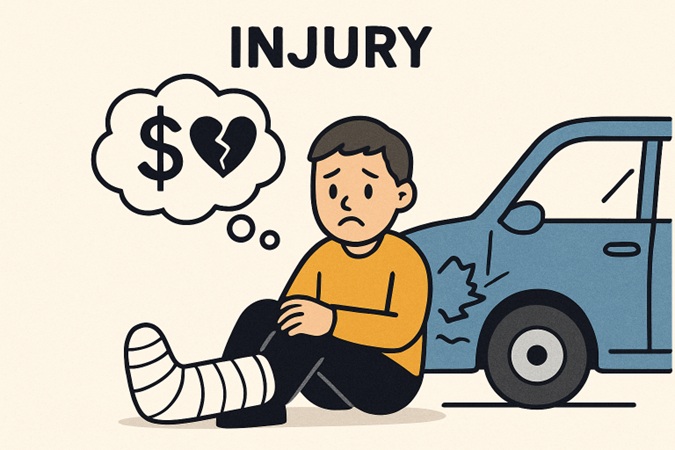Key Takeaways:
- Pain and suffering damages account for both the physical and emotional impact of an accident.
- The multiplier and per diem methods are the most common calculation techniques.
- Factors like severity, recovery time, and emotional distress influence compensation.
- Thorough documentation and legal guidance are essential for maximizing your claim.
- State laws may impose limits on total compensation for pain and suffering.
Understanding Pain & Suffering In Car Accident Claims
After a car accident, many people focus on vehicle repairs and immediate medical bills. However, the broader impact extends far beyond these tangible costs. Physical discomfort and emotional trauma—together called “pain and suffering”—often disrupt daily life in lasting ways. But quantifying these very real damages can be challenging for accident survivors and their families.
Every car accident is unique, and so are the effects on victims. The law allows people to claim compensation not only for financial losses but also for the non-economic harm they endure. Understanding how insurance companies and courts calculate such damages, and where to find help—such as blakefriedmanlaw.com—is a crucial first step toward securing the compensation you deserve.
Insurance adjusters and legal professionals consider a range of physical and emotional factors when determining the value of pain and suffering. These can include chronic pain, anxiety, depression, loss of enjoyment of life, and disruption to family or work responsibilities. Because no two cases are alike, having a clear understanding of the process and your personal situation is key when building a strong personal injury claim.

The Multiplier Method
The multiplier method begins by summing your provable economic damages, including medical bills, lost wages, and prescription costs. This figure is then multiplied by a number—usually between 1.5 and 5—that reflects the seriousness and duration of your pain, suffering, and other non-monetary losses. Higher multipliers generally correspond to injuries causing significant or long-term suffering, permanent disability, or drastic lifestyle impacts.
The Per Diem Method
The per diem method assigns a daily rate for pain and suffering during your recovery period. For example, you might reasonably claim $200 for each day you were impacted, and multiply by the number of days you endured pain and limitations. This method is most effective in cases with a clear timeline for recovery, and the chosen daily rate should align with the severity of your injuries and your typical daily activities.
Factors Influencing The Calculation
No standard formula can perfectly account for every individual’s experience, so several factors impact the final value:
- Severity of Injuries: More severe injuries—such as broken bones, traumatic brain injuries, or permanent impairments—warrant higher awards.
- Duration of Recovery: A longer recovery period means more days of pain, hospital visits, and a loss of enjoyment of life.
- Impact on Daily Life: Injuries that affect your ability to work, care for your family, or pursue hobbies can increase claims for pain and suffering.
- Emotional Distress: Mental health issues like depression, sleep problems, and anxiety are considered legitimate aspects of non-economic damages.
Documenting Your Pain & Suffering
Clear and thorough documentation is essential when claiming compensation for pain and suffering. Insurance companies and courts rely heavily on written and verbal evidence to determine the validity and severity of your claim.
- Medical Records: Retain all doctors’ notes, diagnosis reports, prescriptions, and physical therapy records.
- Personal Journals: Keep a detailed diary describing your pain levels, daily challenges, sleep patterns, and emotions. Note specific events that highlight how your life has changed post-accident.
- Testimonies: Ask family members, friends, or colleagues to provide statements describing the way your injuries have altered your behavior and capacity for daily tasks.
State-Specific Considerations
Pain and suffering compensation is not treated the same way in every U.S. state. Some states enforce “caps” that limit the amount recoverable for non-economic damages, especially in personal injury or auto accident cases. For instance, some jurisdictions set caps between $250,000 and $750,000, which can dramatically affect your claim’s potential value. Understanding these rules can help set realistic expectations and inform your legal strategy.
Seeking Professional Guidance
Navigating the process of calculating and proving pain and suffering can be daunting, particularly when facing insurance companies with their own teams of adjusters and attorneys. Consulting with a qualified legal professional offers critical advantages—ensuring you understand your rights, gathering vital documentation, and pursuing the maximum possible settlement or award for your suffering.
Final Thoughts
Pain and suffering following a car accident are complex and deeply personal. While financial compensation cannot erase trauma or restore your health, a fair settlement can ease financial burdens and recognize the profound impact of your experience. By learning about your legal options, thoroughly documenting your struggles, considering state-specific laws, and seeking knowledgeable guidance, you put yourself in the strongest possible position to recover—both emotionally and financially.
